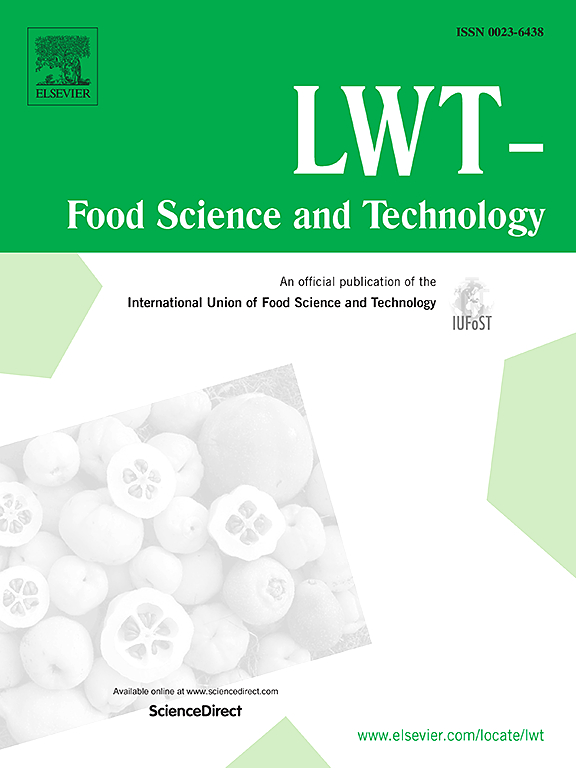真空油炸是提高葵花籽油氧化稳定性的一种替代技术。对含氧化合物进行了全面的1H NMR和SPME-GC/MS研究
IF 6.6
1区 农林科学
Q1 FOOD SCIENCE & TECHNOLOGY
引用次数: 0
摘要
本研究比较了葵花籽油在真空油炸(120°C,低压)和常规油炸(170°C,常压)下的氧化稳定性,重点研究了氧化产物的形成。为了区分真空油炸过程中温度和氧气浓度降低的影响,还对葵花籽油在120°C常压油炸条件下的稳定性进行了评价。采用质子核磁共振(1H NMR)、固相微萃取(SPME)、气相色谱/质谱(GC/MS)分析油样。此外,测定了总极性化合物(TPC)的百分比和粘度。在真空油炸条件下,亚油酸酯的降解速度比常压油炸条件下慢。同样,不同的氧化化合物,包括单氢过氧-单羟基-和单酮共轭十八烯二酸酯,z -单环氧- z -十八烯二酸酯和醛的形成也被推迟,其中一些是潜在有害的。同样,TPC百分比和粘度变化的演化速度也较慢。这些结果首次全面了解了真空油炸对葵花籽油稳定性的影响,突出了它作为传统油炸方法的有前途的替代品的潜力。本文章由计算机程序翻译,如有差异,请以英文原文为准。
Vacuum frying as an alternative technique to increase the oxidative stability of sunflower oil. A comprehensive 1H NMR and SPME-GC/MS study focused on oxygenated compounds
The present study compares the oxidative stability of sunflower oil during vacuum frying (120 °C, low pressure) and conventional frying (170 °C, atmospheric pressure), focusing on the formation of oxygenated oxidation products. To discern between the effects of temperature and reduced concentration of oxygen during vacuum frying, the stability of sunflower oil under atmospheric frying conditions at 120 °C was also evaluated. Oil samples were analysed using Proton Nuclear Magnetic Resonance (1H NMR) and Solid Phase Microextraction (SPME) followed by Gas Chromatography/Mass Spectrometry (GC/MS). Additionally, the percentage of Total Polar Compounds (TPC) and the viscosity were determined. Under vacuum frying conditions, the degradation rate of linoleate was slower than under atmospheric frying conditions. Likewise, the formation of different oxygenated oxidation compounds, including monohydroperoxy- monohydroxy- and monoketo-conjugated-octadecadienoates, Z-monoepoxy-Z-octadecenoates and aldehydes, some of which are potentially harmful, was also delayed. Similarly, the evolution of the TPC percentage and viscosity changes showed a slower rate. These results provide, for the first time, a comprehensive understanding of the effect of vacuum frying on the stability of sunflower oil, highlighting its potential as a promising alternative to conventional frying methods.
求助全文
通过发布文献求助,成功后即可免费获取论文全文。
去求助
来源期刊

LWT - Food Science and Technology
工程技术-食品科技
CiteScore
11.80
自引率
6.70%
发文量
1724
审稿时长
65 days
期刊介绍:
LWT - Food Science and Technology is an international journal that publishes innovative papers in the fields of food chemistry, biochemistry, microbiology, technology and nutrition. The work described should be innovative either in the approach or in the methods used. The significance of the results either for the science community or for the food industry must also be specified. Contributions written in English are welcomed in the form of review articles, short reviews, research papers, and research notes. Papers featuring animal trials and cell cultures are outside the scope of the journal and will not be considered for publication.
 求助内容:
求助内容: 应助结果提醒方式:
应助结果提醒方式:


